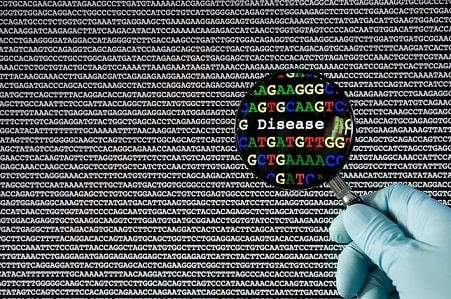
Time for pharma to think big on genomics research
pharmafile | October 12, 2015 | Feature | Research and Development | Sir John Chisholm, genomics
Sir John Chisholm, executive chair of Genomics England, is very clear about what the project he is overseeing is – and what it is not.
“We are not a clinical trial or a research project. We are formally classified, including by Government, as a ‘transformational project’,” he tells Pharmafocus.
It’s this theme of transformation that runs through our meeting with him, at the Genomics England office in central London, in the run-up to the project’s launch. Sir John’s task is to transform several traditionally conservative aspects of the NHS, R&D and the pharma industry in one swoop.
“We are on the leading edge of the transformation of the NHS, from one that is largely mediated by ‘greybeards’ that have been in the business for years,” he tells Pharmafocus.
“When the digital revolution goes through an industry it changes things; because then you have
digitally-driven expertise and you can capture knowledge and then dispense it in a very orderly way
– this for sure will transform the health industry, and indeed the pharma industry that supports it.”
As its head, Sir John is leading Genomics England – which was set up and established as a company
by the Department of Health – in its promise to deliver a flagship project that will sequence 100,000 whole genomes from NHS patients and their families by the end of 2017.
At its inception in 2013 – ten years after the completion of the Human Genome Project – health secretary Jeremy Hunt promised the venture would “kickstart the development of a UK genomics industry.” The project is a collaboration with the National Institute for Health Research, NHS England, Public Health England and Health Education England.
Two years later and Sir John, a former chair of the Medical Research Council who was appointed to lead Genomics England after a career in engineering and the defence industry, says the time is right for patients to start seeing the fruits of these kinds of Big Data projects.
We are, it seems, at a stage where it might just be financially feasible to gather together enough genomes to make a major effort to begin to understand the health significance of our genes and their regulation.
Delivering on the promise
“The distinctive feature of the 100,000 Genomes Project is that it’s not just genomes; they are fully integrated with routine clinical data drawn from the NHS. We are fortunate to be able to draw on these as we have very strong genomic science here in the UK.”
This unique combination is of particular interest to the pharma industry, Sir John notes. “It’s well understood in the pharma world that getting hold of routine clinical data is not so easy. So this tackles two big problems for pharma: potentially providing access to 100,000 genomes, and putting that together with quality clinical data.”
The UK is not the only country with ambitious Big Data plans, although Genomics England does eclipse them in scale – it is around twice as large as any other database. For example in the US, President Obama has pledged to spend $215 million on a personalised medicine initiative, which includes commitments to scale up efforts to identify genomic drivers in cancer.
But Sir John says the availability of NHS records offers the UK a significant head start in this area.
“Obama won’t be able to deliver it without buy-in from different people, healthcare insurers, or going back to patients and getting consent – it’s a nightmare if you don’t have a single system to operate from.
We have the NHS and very strong genomic science in the UK, the golden triangle and in Edinburgh.” This has already been tapped into, in order to create 11 genomic medicine centres that have so far sequenced around 3,000 full human genomes, at the rate of about 60 a day, with a focus on cancers, rare diseases and some pathogens.
Importance of commercial gains
“Our aim is to generate patient benefit from the pertinent findings we intend to make from our analyses. Another aim, which is just as important, is to use the project to generate industrial and commercial activity.” This was a clear directive from the start of the project, and makes collaboration with pharma – who can deliver commercial gains from the outputs of the project – a necessity, not just a nice-to-have.
“The project has to be used to generate and ferment industrial and commercial activity. That was very much part of the remit from the very beginning. The knowledge that we derive from what we’re doing must have a good chance of being translated into either therapeutics or diagnostics, with material financial gain.”
In March, Genomics England announced that it will partner with 10 pharma and biotech companies to develop new diagnostics and treatments for people with rare diseases and cancers, using the genomic sequences gathered through the 100,000 Genomes Project.
The companies – including AbbVie, Alexion Pharmaceuticals, AstraZeneca, Biogen, GSK, Roche, Takeda and UCB, will work in a public-private partnership called the GENE Consortium to analyse the DNA sequences and find new research targets.
The companies are working on a pilot programme to look at the first 5,000 linked datasets, and received the first tranche of the data in August. The collaboration will be crucial in driving the project forward and delivering tangible results – in the form of new drugs and diagnostics, Sir John says.
“The companies in the consortium bring a huge knowledge of candidate molecules, understanding of the regulatory environment, and pharmacological demand that wouldn’t naturally come to us; the things that would add the greatest value to the health community.
“Having people from pharma, who live the translation model, engaged right at the start will enable us to shape what we’re doing, to be maximally translatable and useful in terms of therapies and diagnostics.”
Changing the pharma business model
However, not all of the industry is geared up to take advantage of a Big Data project of Genomics England’s size and scale. And while there are big, global companies in the GENE Consortium, many of them may lack the nimbleness, or perhaps willingness, to be able to seize upon a radically different business model.
A 2013 report by McKinsey and Company found that nearly a third of drugs under clinical development were associated with a genomic or proteomic marker, a rise of 50% in over the previous two years. But within the top 15 pharma companies, there was a significant variation in investment in biomarker research.
The leaders allocated 3-4% of their R&D spend to these biomarkers, compared to 0.5% in the lowest spenders – an eight-fold difference. It also found that – with the exception of a few companies – the organisational effectiveness needed to maximise this way of working was poor, with companies organised in ad hoc, patchwork manner. This is something Sir John recognises.
“Not many pharma companies have been constructed around the model of the potential for genomic medicine,” he says. “It doesn’t fit neatly into most pharma companies’ business model – the idea that it’s feasible to get a molecular diagnosis for a patient. It’s not something that companies have previously based their models on or has formed part of their thinking.
“At executive level, pharma companies are all aware that yesterday’s business model has to change,” he adds. “There’s no shortage of understanding that this is something that really has to be explored. But do companies – today – have a blueprint of how to make that happen, how to organise their business and the skills they are going to have to have? Of course they don’t. This change is going to affect the whole of the industry, as well as patients and regulators. But pharma companies can only go as fast as their customers want and is right for them; there’s work to do on all sides.”
Need for change in genomic medicine
The change in the system will also extend to drug regulators, and the NHS – which Sir John feels still has plenty of work to do to meet another of the Project’s aims: to introduce genomic medicine into the health service. Time will tell whether it is ready, and of course there will be problems.
He says: “To say that everyone in the NHS is already an expert in genomic medicine would be an outrageous claim, but those parts of the system that are most closely aligned – the NHS genetics service, for example – are well engaged. The genomics centres exist now where they didn’t before. That in itself is quite a revolutionary step, although to be fair they are only just now getting themselves up to speed.
“It probably wasn’t the most popular announcement ever made, because it involves a change. But the Five-Year Forward View [published by Sir Simon Stevens on the future of the health service] is formed around the idea that technologies like genomic medicine will provide an information base for the NHS to provide more personalised diagnoses.”
Short-circuiting pharma R&D efforts
After changing minds in the pharma industry and the NHS on the value of genomics and big data, Sir John has drug regulators on his list of people to convert to a new way of thinking, to embrace the genomics revolution.
He envisions a time when regulators require fewer or different regulatory trials to the ‘gold standard’ randomised controlled trials typically demanded of pharma companies today, to trials that focus instead on evaluating the accuracy of a molecular diagnosis.
“We are working with regulators so they might understand the model better. Clearly if you can understand enough at the molecular level to have worked out how to treat a condition – because we know what molecule, enzyme, or protein we have to target – and you can bring that out of the dataset, then you’re short-circuiting the whole process.”
He feels that by ‘short-circuiting’ the drug R&D process in this way, pharma companies who adapt to a new business model could drastically reduce their R&D costs – and ultimately reduce drug prices by taking advantage of ‘potentially vast economies of scale’.
Although most companies are not geared up for the change, the one example he does cite as an exception is Alexion’s Soliris (eculizumab) – commonly dubbed ‘the world’s most expensive drug’. Soliris was developed according to a molecular diagnostics model yet costs £330,000 for each of the estimated 200 people with the extremely rare disease, atypical Haemolytic Uraemic Syndrome (aHUS), who will be treated every year.
“Alexion have produced a therapy for a very rare disease, therefore all their patients have a molecular diagnosis for their disease. In a sense that’s a harbinger of how you might imagine the future unfolding.
“But we’re a very long way from being there at the moment. The reason drugs are so expensive is that they take years to get to market; and you’re needing to cover the cost of all that. The cost of Soliris is high, but it’s a one-off. It did not fall out of a huge programme like we’re doing, it didn’t fall out of system set up in the way that Genomics England is, designed to provide that level of insight.”
So will pharma companies be able to use the genomes to streamline R&D and ultimately deliver cheaper drugs? There will be future opportunities for companies to add expressions of interest in joining the GENE consortium, which points towards greater collaboration between Genomics England and the industry.
But Sir John is under no illusions about the amount of effort it will take him and his colleagues to deliver not only 100,000 genomes, but the transformation in genomics and R&D that the project has promised. Indeed, as he says, 100,000 genomes may not even be enough to create a revolution in the industry, and it may require input and consolidation from other databases globally. However this is the best start the industry and the NHS will ever have, he says.
“There’s a reason no one’s done this; that’s because it’s bloody difficult and we are bumping up against challenges every day. No one knows what the data we are collecting means at the moment; that’s the consequence of working at the edge of science. But what I do know, and I’m very confident of, is that by the time we’ve done 100,000 we will know a hell of a lot more than we know at the moment.”
Related Content

AstraZeneca’s Alexion partners with Pfizer for rare disease therapies
Alexion, AstraZeneca’s Rare Disease division, has announced that it has entered a definitive purchase and …

Manchester emerges as genomics research hub
Manchester, UK is emerging as a major hub for genomics research, according to a new …

Top Ten most popular articles on Pharmafile.com this week!
The US Department of Justice has launched an investigation into the sales and marketing practices …








